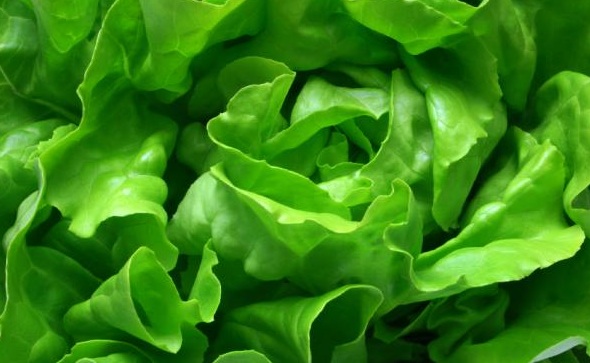
Features
Production
Vegetables
Researchers tackle safety of leafy greens
October 28, 2011 By Ohio State University
 October 27, 2011,
October 27, 2011,
Columbus, OH – Leafy green vegetables are a growing part of the average
American diet. Yet in 2009, leafy greens also made the Center for Science in
the Public Interest’s Top 10 Most Dangerous Foods, due to a surprising number
of foodborne illnesses linked to the salad staple.
October 27, 2011,
Columbus, OH – Leafy green vegetables are a growing part of the average
American diet. Yet in 2009, leafy greens also made the Center for Science in
the Public Interest’s Top 10 Most Dangerous Foods, due to a surprising number
of foodborne illnesses linked to the salad staple.
A team of researchers
with Ohio State University’s Ohio
Agricultural Research and Development Center (OARDC) is working on
an answer.
 |
|
According to the Food
and Drug Administration, 82 foodborne illness outbreaks between 1996 and 2008
were linked to the consumption of fresh produce. More than one-third of them
were traced to leafy greens, accounting for 949 illnesses and five deaths. One
outbreak alone, the 2006 contamination of spinach with Escherichia coli
O157:H7, caused 204 illnesses, including 104 hospitalizations, 31 cases of
hemolytic-uremic syndrome (a serious complication), and three deaths. On top of
the human cost, the economic impact of that outbreak alone was estimated at
anywhere from $37 million to $75 million.
“Leafy greens – spinach,
lettuce – are the most difficult type of fresh produce to treat,” said Ahmed
Yousef, food microbiologist and professor of food science and technology at
Ohio State. “The leaves are porous. That allows the plant to respire, but it
also makes it easy for pathogens to enter into the leaf – not just stay on the
surface. And, leaves are much more sensitive to treatment than other types of
produce. We have been trying to figure out how to kill microorganisms without
damaging the leaf at the same time. There’s not a large margin for error.”
Freshly harvested leafy
greens are often vacuum-cooled, washed and sanitized with chlorine solution
before packaging.
“But research shows
liquid sanitizers are not always effective, and sometimes make the problem
worse,” said Ohio State food engineer Gonul Kaletunc.
The problems are
twofold, the scientists explain:
- Air bubbles can form
in the liquid sanitizer, preventing it from ever reaching portions of the leaf
surface. - Even when liquid
sanitizer does come in contact with the surface, it may not have enough time to
penetrate the leaf deep enough to reach microbes.
“If you have a bacterium
sitting one millimeter inside a leaf surface cavity, and your sanitizer doesn’t
touch the bacterium, it’s not going to have any effect,” said Sudhir Sastry,
food safety engineer and leader of this effort.
That’s why the team,
armed with a $1 million grant from the U.S. Department of Agriculture, has
turned its attention to studying the effectiveness of gaseous sanitizers,
including ozone and chlorine dioxide.
“To get into the
crevices of the leaf, it’s got to be gas, not liquid,” said Yousef.
Although gaseous
sanitizers have a better chance of reaching the pathogens that can sicken and
kill, they also need specific conditions to work. And that causes a challenge,
Sastry said.
“At the processing
stage, everything is geared to speed, speed, speed,” Sastry said. “But
sanitizers, especially the liquid sanitizers, are slow, slow, slow, which is
not compatible with a high-speed operation. So, we looked at the whole process
and thought, ‘Why not apply the sanitizer when there is some time to let it work?’”
For example, larger
processors use vacuum cooling for a half-hour or longer after the harvest and
before the greens are transported for packing.
“To use gas as a
sanitizer, you need an airtight compartment,” said Kaletunc. “You have that
with vacuum cooling, and vessels that are currently being used can be adapted
to use gas.”
Another possibility is
to subject the greens to a sanitizing gas during transportation.
“Greens are in transit
up to 96 hours,” Sastry said. “Why not subject them to the sanitizing gas then,
when there’s plenty of time for it to work? We need to be able to incorporate a
gaseous sanitization procedure into the produce chain’s existing operations –
that will be key.”
One OSU study, published
in 2009 in the Journal of Food Protection and conducted by Sastry, Yousef and
two of their graduate students, found that a combination treatment using ozone
gas during vacuum cooling and transportation reduced E. coli on spinach leaves
by up to 99.999 per cent. In the current project, the researchers are further
studying possible combinations of gaseous sanitizer – both ozone and chlorine
dioxide – and partners at Iowa State University are examining the use of liquid
organic acids combined with surfactants to determine if those would be as effective.
Additional partners at New Mexico State University are preparing training
materials for growers and processors. A half-dozen produce companies from
across the U.S. have attended project meetings and expressed interest in the
work, Sastry said.
Print this page